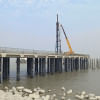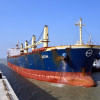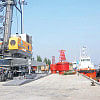Payra port: Poor navigability jacks up coal import cost

Just six months after Tk 6,500 crore was spent on capital dredging, Payra Port's Rabnabad channel has lost much of its navigability, pushing up coal transport costs for the power plants in the area.
Mother vessels carrying coal from abroad for two power stations are unable to dock at the port jetty, forcing the plants to bear the extra cost of lightering.
Patuakhali's Kalapara upazila along the Rabnabad river houses the 1,320MW Payra Thermal Power Plant. Boasting ultra-supercritical technology, the plant began its operations in 2020.
The Rural Power Company Limited's plant in the area is nearing completion, while the Ashuganj power plant is under construction. Both the stations will have a capacity to generate 1,320MW each.
The coal for these plants is brought from Indonesia through the Rabnabad channel, officials of the power plants said.
Many other companies rely on this channel and port to import nine other commodities, from limestone to LPG.
The Belgian contractor Jan de Nul completed the capital dredging of the 75km long channel with 100-125m or higher width by April 26. The dredging allowed vessels with a draft of 10.5m to enter the port.
But the triumph was short-lived. With a glaring lack of maintenance dredging, the channel's depth plummeted to dangerous levels — below 6.5m at high tide and 5.9m at low tide, according to officials of the power stations and the Payra Port Authority (PPA).
No mother vessel, that requires a minimum depth of 10m, can reach the jetty now. Port users face skyrocketing costs as coal must be lightered at the outer anchorage.
Shah Abdul Mawla, project manager of the Payra Thermal Power Plant, paints a dismal picture. "We're incurring an additional $10 to $12 per tonne in lightering costs. This additional expense is a burden on power generation."
Without immediate dredging, transportation costs will soar, and user dissatisfaction will grow, the power station officials said.
Zobair Ahmed, supervising engineer of the Payra Thermal Power Plant, highlighted an alarming reality. "The plant meets 10 percent of the nation's electricity demand. Each month, we burn over 300,000 tonnes of coal. Direct jetty access would have cut costs, but the channel's depth is already dwindling. This winter could see it drop below 5m, hiking costs even further."
Salim Bhuiyan, managing director of Rural Power Company Limited, echoed the concerns of the Payra plant officials. He said they alerted the PPA about the depth crisis and the PPA promised to raise the issue in high-level meetings with the shipping ministry and the Power Division.
Abu Saeed, a top official of Radiant Shipping, warned of dire consequences if maintenance dredging did not start soon.
"The Rabnabad channel was silting up even before the dredging was completed. Reduced navigability means higher costs and longer delays. If this persists, we'll have to seek alternatives to using the port. Maintaining navigability is crucial."
Captain SM Sharifur Rahman, harbour master of Payra port, shares disheartening statistics. Post-dredging, only 200 mother vessels with a 10.5m draft could reach the jetty. But as navigability waned gradually, lightering became necessary again.
On May 1, the channel's depth was 9.3m, shrinking to 7.7m by June 1, and a mere 7m by September 11. As of November 20, it stands at a precarious 6m, officials said.
Rear Admiral Abdullah Al Mamun Chowdhury, chairman of PPA, acknowledged the struggle, saying year-round dredging is vital.
After the maintenance dredging contract expired on April 30, emergency dredging was conducted until August 14, but the channel is silting up constantly.
"While there was initial consent for two more years of dredging, circumstances have stalled a decision. We're also procuring hopper dredgers to boost our dredging capacity. The next steps depend on the shipping ministry," Mamun said.
Despite the navigability crisis, Payra Port's activity is on the rise. Formal operations, starting on August 13, 2016, have seen a boost.
Just 10 ships docked at the port in the 2016-17 fiscal year, and the number rose to 1,040 in 2023-24. By October 28 this year, the port managed 3,160 ships, including 484 foreign commercial vessels, according to PPA data.
This boom generated around Tk 1,576 crore in revenue for the government, the data showed.

 For all latest news, follow The Daily Star's Google News channel.
For all latest news, follow The Daily Star's Google News channel. 










Comments